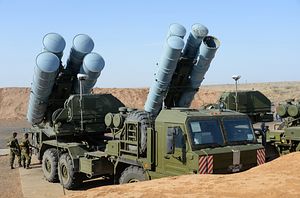Chinese People’s Liberation Army Rocket Force (PLARF) servicemen are currently inspecting the second regimental set of Russian-made S-400 Triumf long-range interceptor-based air defense systems (NATO reporting name: SA-21 Growler) at a military base in southern Russia.
A Russian defense source told TASS news agency on May 22 that the second S-400 regiment will be dispatched to China at the end of July. “At the Kapustin Yar practice range, the Chinese military specialists started a technical inspection of the second S-400 regiment set that will be dispatched to China in late July,” the source said. “Test firing from S-400 system is not envisaged at the practice range.”
Russia has been training PLARF personnel on the S-400 air defense system in 2018 and throughout 2019. A Russian government source confirmed in April that the delivery of the second S-400 regiment will begin in late July. Initially, the second batch of S-400 air defense system was supposed to have been delivered by the end of 2018. Yet, missile systems en route to China where damaged during a storm in the English Channel in early 2018, delaying the completion of the order by a couple of months.
Russia at the time claimed that the cargo ship carried an export variant of the S-400’s most advanced interceptor, the 40N6E, reportedly capable of intercepting targets at a distance of up to 400 kilometers, while the missile’s maximum altitude for target interception is estimated at about 30 kilometers.The Russian Ministry of Defense (MoD) first released details of the 40N6E during the 2018 Army Forum in August. It still unclear whether the missile has been officially inducted into the Russian Armed Forces. As I wrote in March:
The standard S-400 battery consists of four transporter erector launchers (TELs) with four large launch tubes or 16 smaller tubes (or a combination of the two) per TEL, in addition to long-range surveillance radar target acquisition and engagement (fire control) radar systems and a command post (vehicle). In the Russian military, two batteries make up an S-400 battalion (also known as an S-400 division), whereas an S-400 regiment consists of two battalions.
Each TEL can carry four long-range or up to 16 short- and medium-range missiles. An S-400 regiment also possesses additional surveillance and target acquisition radars, with the unit generally plugged in to larger long-range radar stations or airborne early warning systems. It is, however, unclear whether Russia has developed such a so-called Cooperative Engagement Capability (CEC). An entire regiment can be airlifted.
The PLARF conducted a number of S-400 missile tests in 2018. It is unclear whether the service test-fired the S-400 long-range air defense system in 2019 so far. The PLARF will induct a total of two regimental sets. China was the first international customer to place an order for the Russian-made S-400 air defense system in 2014. The contract value is estimated at around $3 billion.































